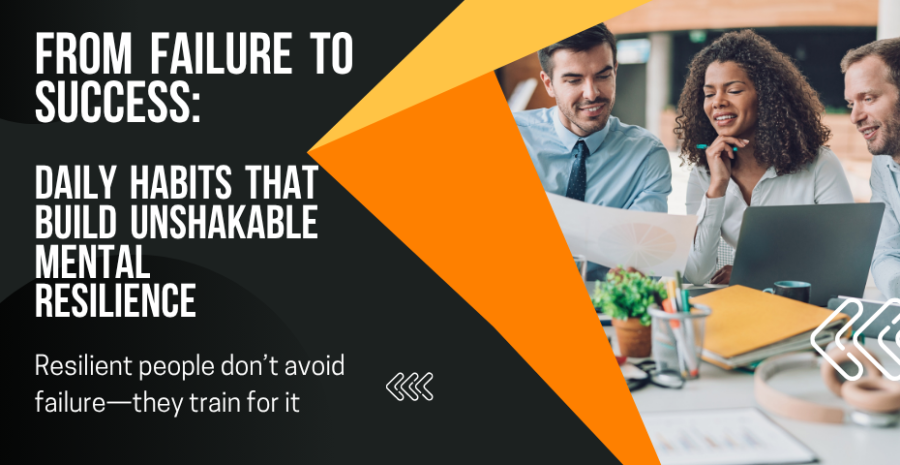From Failure to Success: Daily Habits That Build Unshakable Mental Resilience

Introduction
Failure. It's a word that can paralyze even the most ambitious minds, yet it is also the birthplace of every great success story. From world-class athletes to billion-dollar entrepreneurs, one thing binds them all: they’ve failed—often, publicly and painfully.
What sets them apart is not avoidance of failure, but how they respond to it. In a culture that idolizes success and shames setbacks, learning how to reframe failure as a stepping stone is a superpower. Mental resilience—the grit to keep going when life punches you in the gut—isn’t inherited.
It’s built. Day by day. Thought by thought. Habit by habit. For those stuck in cycles of doubt, disappointment, or discouragement, know this: you are one decision away from turning your trajectory around. The key lies not in grand life overhauls, but in small, consistent practices that train your brain and spirit to rise when everything inside you says quit.
This blog isn’t just about bouncing back—it’s about bouncing forward. It's your map for moving from failure to success through simple, actionable, and life-transforming daily habits. If you’ve ever felt like giving up, like success is for others but not for you—read on.
Because inside this guide are the mental tools and mindset shifts that can take you from where you are now to where you dream to be. What follows are seven powerful habits, each forged in the fire of failure and polished by discipline, that will rewire your mind for resilience and sharpen your capacity to overcome, adapt, and win.
Every habit outlined here is more than a productivity hack—it’s a decision to become the kind of person who can handle success because you’ve already learned how to handle failure. Whether you're rebuilding after a loss or preparing for a breakthrough, your comeback starts here.
Let’s turn breakdowns into breakthroughs, pain into purpose, and fear into fuel.
1. Start Each Day with Intentional Mental Framing

Your mind is the battleground where victory or defeat is decided before you even step into the arena of life. Most people begin their day in reaction—scrolling social media, reading the news, or diving into emails. But resilience is built through intentionality.
Starting your day with focused mental framing—through affirmations, gratitude, visualization, or prayer—can redirect your thoughts away from fear and failure toward strength and solutions. This is not mere positive thinking; it’s training your mind to recognize opportunity in adversity.
Think of it as suiting up for battle before stepping into the field. Visualize your day with clarity. Picture the challenges—and yourself overcoming them. Declare truths that align with your goals, even when your feelings don't.
This habit not only strengthens your mental toughness over time but also short-circuits anxiety, self-doubt, and distraction. Intentional mental framing is how you become the person who sees a loss not as a defeat but as data—feedback for future success.
It's the difference between being tossed by the storm or being the one who sails through it with purpose. And when practiced daily, it builds an internal compass that keeps you grounded regardless of external chaos. The mind, after all, obeys the directions it’s given consistently.
Frame your day with power, and watch your life begin to mirror your mental clarity.
2. Build Failure Immunity Through Micro-Risks

Resilient people don’t avoid failure—they train for it. One of the most powerful ways to grow your mental toughness is to deliberately step outside your comfort zone each day by taking small, calculated risks.
These are not life-threatening decisions but simple daily actions that expose you to rejection, resistance, or discomfort. Make that sales call. Post your idea online. Try that new skill. Ask the question you’re scared to ask. Each micro-risk is like a rep in the mental gym.
The more you do it, the less scary failure becomes. Over time, your nervous system recalibrates: what once felt threatening begins to feel normal. This process builds what psychologists call “exposure resilience”—your capacity to face challenges without emotional shutdown.
Just as athletes train muscles through controlled stress, you build emotional endurance through intentional micro-failure. You begin to realize that failure doesn’t destroy you—it grows you. It becomes your teacher, your feedback loop, your sharpening stone.
And the best part? As your failure immunity grows, so does your confidence. You no longer hesitate to take bold action because you’ve become familiar—even friendly—with discomfort.
You’ve trained yourself to lean in rather than run. In the long game of success, those who win aren’t those who fail least but those who are least afraid to fail.
3. Journal Your Thoughts to Master Your Inner Narrative

Every setback you experience triggers a story in your head. “I’m not good enough.” “I’ll never get this right.” “Why even try?” These internal narratives—often invisible and automatic—shape your emotional state and behavior more than the failure itself.
That’s why journaling isn’t just a nice-to-have—it’s a mental resilience weapon. By writing out your thoughts each day, you externalize your inner monologue. You create distance from it. You gain power over it. Journaling allows you to identify distorted thinking, challenge your assumptions, and re-author your personal story.
It's like debugging your mental code. When done daily, even for 10 minutes, it can shift your mindset from reactive to reflective. Instead of being overwhelmed by emotion, you observe it, learn from it, and move through it.
You begin to catch yourself in the act of limiting beliefs and replace them with empowering ones.
Journaling turns vague frustration into clarity, and pain into perspective. Over time, your written reflections become a trail of growth—a testament to your resilience. You’ll look back and realize the moments that once crushed you are now the very things that built your strength.
And most importantly, you’ll start telling yourself a better story. One where you're not the victim of your failures but the hero rising through them.
4. Move Your Body to Strengthen Your Mind

It’s easy to think of mental resilience as purely cognitive—thoughts, beliefs, mindset. But your body plays a crucial role in how you process failure and stress.
Daily movement—whether it's a brisk walk, gym session, yoga, or stretching—is not just physical exercise; it’s mental fortification. Exercise increases endorphins, reduces cortisol, and boosts neuroplasticity—the brain’s ability to adapt and grow.
More importantly, it teaches you discipline, endurance, and how to keep going when things get tough. The same grit required to finish that last set or run that extra mile is the grit needed to push through emotional pain.
Movement regulates your nervous system, helping you stay calm and clear-headed in the face of setbacks. When you move your body, you activate resilience—not just physically, but mentally. It reminds you that you are strong, capable, and in control.
It reconnects you with your agency when failure makes you feel powerless. Making physical movement a daily non-negotiable creates a feedback loop of energy, focus, and confidence. It’s not about sculpting a six-pack—it’s about sculpting a spirit that won’t quit.
Because the person who trains their body to move through resistance learns to do the same in life.
5. Feed Your Mind with Empowering Inputs

What you consume daily—books, podcasts, conversations, media—either builds you or breaks you. Your brain is a sponge, and the content you allow into your consciousness becomes the material from which your thoughts are made.
Resilient people curate their inputs like their future depends on it—because it does. Start your day with empowering content: listen to motivational podcasts, read biographies of those who overcame failure, watch talks that challenge and uplift.
Limit exposure to toxic news, gossip, and social media negativity. Choose inputs that align with the mindset you’re trying to build, not the one you’re trying to escape. Feeding your mind with high-quality content builds your internal belief system. It reminds you that you’re not alone.
That failure is not final. That growth is possible. It infuses your mental world with the voices of strength, hope, and vision. And in moments of self-doubt, those inputs become your lifeline. They shape your inner dialogue, your outlook, and your decisions.
Like sharpening a blade, this daily habit keeps your perspective sharp and your motivation high. Don’t underestimate the power of a five-minute podcast to shift your entire day—or the compound effect of 10 pages a day to rewire your brain over months.
Your inputs shape your inner world. Guard them like your dreams depend on it—because they do.
………………………………………………………………………………………………………………………………………………………………..
6. Practice Reflection and Reframing Every Evening

At the end of each day, most people either collapse into distraction or drown in regret. But high-resilience individuals do something different—they reflect and reframe. This habit is a mental reset that transforms every experience, especially failures, into fuel for growth.
Spend 10 to 15 minutes each evening reviewing your day. Ask yourself: What went well? What could I learn from what didn’t? What am I proud of? What will I do differently tomorrow? This is not about guilt or perfection—it’s about observation without judgment.
Through this reflective practice, you learn to separate outcomes from identity. A mistake doesn’t mean you are a failure—it just means you found another way not to do something. Reframing allows you to see setbacks not as dead ends, but as data.
You start to notice patterns in your thoughts, behaviors, and decisions. And that awareness is the seed of transformation. With repetition, this habit rewires your mind to look for lessons instead of losses, feedback instead of failure.
The evening reflection becomes your secret weapon: a way to mine gold from the dirt of everyday struggles. Over time, this builds a mindset that isn’t shaken by defeat, because it’s trained to find strength in the rubble. Every reflection session becomes an opportunity to choose better, think better, and rise stronger the next day.
It turns failure into your personal curriculum for success.
7. Surround Yourself with Resilient, Growth-Minded People

You become like the people you spend the most time with. If you’re constantly surrounded by complainers, victims, and excuse-makers, your mental resilience will suffer. But if your circle includes people who challenge you, support you, and model resilience, your mindset will rise to meet theirs.
Building mental toughness is not a solo mission. You need community—people who see your potential even when you don’t. People who don’t let you stay down. Resilient people aren’t perfect, but they’re persistent. And their energy is contagious.
So be intentional about your inner circle. Join mastermind groups. Engage in accountability partnerships. Connect with mentors who’ve failed, risen, and built success from the ashes. Conversations with the right people can unlock courage you didn’t know you had.
They can reframe your perspective in a single sentence. They remind you who you are when life tries to make you forget. And their very presence can keep you anchored when everything feels like it’s falling apart. Protecting and curating your environment is not optional—it’s essential.
You’ll still face storms, but you won’t face them alone. And that support is the wind behind your comeback. As the saying goes, “If you want to go fast, go alone. If you want to go far, go together.” Choose people who help you go far. Build your tribe.
Build your mind. Build your success.
Last Word: Rise Stronger, Every Single Day
Here’s the truth most people never tell you: success isn’t about talent, timing, or luck—it’s about resilience. It’s about waking up one more day, showing up when it’s hard, and doing the work anyway.
It’s about refusing to let failure define you. It’s about deciding—every single day—to keep moving forward, no matter what. The journey from failure to success is not a straight line. It’s a winding path filled with stumbles, detours, and sometimes heartbreak.
But each time you get back up, you’re no longer the same person. You’re stronger. Wiser. Sharper. And more ready than ever for the next level. Mental resilience isn’t some rare superpower. It’s a daily decision to keep going. A series of small habits repeated with purpose.
A mindset that says: “I may fall, but I will rise.” When you practice the seven habits shared here—intentional mental framing, taking micro-risks, journaling your thoughts, moving your body, feeding your mind, reflecting at night, and surrounding yourself with the right people—you are not just surviving failure.
You are using it. You are sculpting a version of yourself that’s ready for everything success demands. Because success isn’t just about reaching the top—it’s about becoming the kind of person who belongs there. And you get there by refusing to quit at the bottom. If you're reading this, you already have what it takes.
The fact that you're seeking growth means you're capable of achieving it. So, embrace the process. Commit to the habits. Trust the climb. You were never meant to stay down.
You were meant to rise—and rise stronger. Every. Single. Day.
…………………………………………………………………………………………………………………………………………………………………………….
About: Andries vanTonder
Over 46 years selfemployed
He is a Serial Entrepreneur, an Enthusiastic supporter of Blockchain Technology and a Cryptocurrency Investor
Find me: Markethive Profile Page | My Twitter Account | My Instagram Acount | and my Facebook Profile.
Markethive News
.gif)
.png)
.png)
